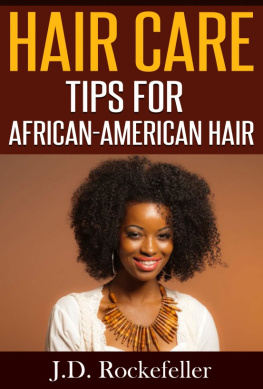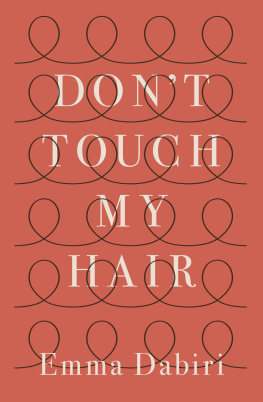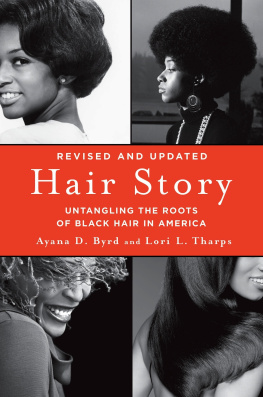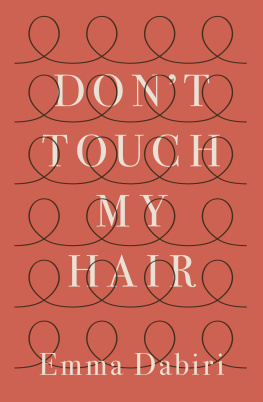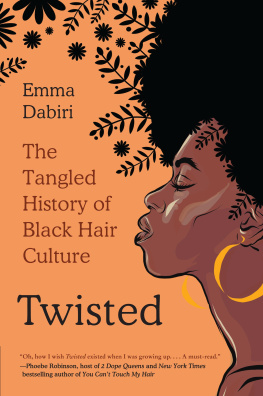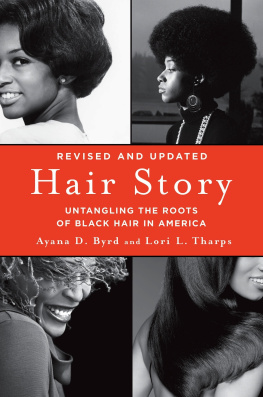

Copyright 2015 by Bert Ashe
All rights reserved. No part of this book may be reproduced or transmitted in any form or by any means, electronic or mechanical, including photocopying, recording, or by any information storage and retrieval system, without express written permission from the publisher.
Portions of this book originally appeared as Invisible Dread, in Blackberries and Redbones: Critical Articulations of Black Hair/Body Politics in Africana Communities. (Cresskill, NY: Hampton Press, 2010.)
The author gratefully acknowledges permission to reprint lines from For the Jim Crow Mexican Restaurant in Cambridge, Massachusetts Where My Cousin Esteban Was Forbidden to Wait Tables Because He Wears Dreadlocks, from A Mayan Astronomer in Hells Kitchen: Poems by Martin Espada. Copyright 2001 by Martin Espada. Reprinted by permission of W. W. Norton and Company, Incorporated.
Library of Congress Cataloging-in-Publication Data
Ashe, Bert.
Twisted : my dreadlock chronicles / Bert Ashe.
pages cm
Summary: A personal account of an African-American professors mid-life experiences when he decides to grow dreadlocks, with a cultural and political history of dreadlocks--Provided by publisher.
ISBN 978-1-572847-49-1
1. Dreadlocks. 2. Hairdressing of African Americans. 3. Hairstyles--Social aspects--United States. 4. Beauty, Personal--Social aspects--United States. 5. Ashe, Bert. 6. African American men--Race identity. 7. African American men--Social conditions. I. Title.
GT2295.U5A74 2015
391.5--dc23
2014040169
10 9 8 7 6 5 4 3 2 1
Bolden is an imprint of Agate Publishing. Agate books are available in bulk at discount prices. For more information, go to agatepublishing.com.
For my friend Gerald Brownwho would have fully understood
Contents
Hair issues are among us. We must tease them out, hold them up to the light, and coax them into art.
Lisa Jones, Bulletproof Diva: Tales of Race, Sex and Hair
I killed dreadlocks. It was a crime of passion.
Anyone with eyes can see how dread has spread. If a map of the United States is the countrys headshot in profile, then California is a snub nose, lower Texas is a double chin, and the Great Lakes are three stubby blue dreads sprouting out of an American scalpwith a thick Florida dreadlock dangling beneath the nations neckline. If the hairstyle has become less radical, if its devolved in the last decade or so, dropping from exclusive, Uppercase Dreads to common-denominator, lowercase locks, point fingers directly at me. I walk around campus, cheer at ball games, joke with my kids; I sit at movies, dine at restaurants, worship at church; I live and breathe under black, lipstick-thick tubes of hair that curl out of my head and slide down around my neck and shoulders.
God knows Id always wanted dreadlocks. Wanted them for the longest time. And, finally, I did it: I got twisted. And it was everything Id wanted it to be, as well as nothing Id ever expected. I loved and dreaded dreads. They both satisfied my curiosity and caused me, at times, to be sure I was losing my mind.
The killing was unintentional. But Im confessing, nevertheless, freely admitting to it, intentional or not. You could call it involuntary manslaughter, if you prefer. I call it murder. But thats getting too far ahead of the story, almost to the end, although the end is in the beginning and lies far ahead, to quote Mr. Ralph Ellison, an idiomatic spirit who hovers above my head and breathes down my neck, a man whose derisive laughter I can hear at any waking moment of the day or night
Hair varies, after all. Superman and Thriller-era Michael Jackson have two of the more famous locks of hair-dangling-over-foreheads. But their locks each look slightly different. People use the term a lock of hair as if theyre sure they know what that means, but theres no true consensus. All those individual mental images of a lock, in all those various minds, are all slightly differentand sometimes significantly different. Lock is a deceptively simple term, since the look of an exact lock of hair cannot be strictly determined. A dreadlock? Even less so.
What youre about to read is a dread simulation; it takes the form of a single, heavy dreadlock. The narrative strands weave as tightly as the hair fibers that lock locks together: History ducks and overlaps with culture; the process of locking hair wraps up and around questions of identity; public perception winds down and around racial issues that turn up and curve and twirland it all weaves in and out and around examinations of the nature of style itself. What follows is not linear, cannot be linearbecause dreadlocks are not a linear hairstyle.
Think back to the first time you saw dreadlocks, back when they were still alive. It was such a stylistic disruption from the familiar black hairstyles of the day, even the natural black hairstyles of the day. Consciously or unconsciously, apprehending a head of dread forces the viewer to recalibrate what a hairstyle is supposed to be, is supposed to mean. Do the same when you read on.
Youll see: I was sure Id killed dreadlocks, once and for all time. I just knew that in thirty years the style would be endlessly mocked and ridiculed, parodically worn for ironic effect, the same way the Afro is worn today. (I dont know who killed the Afro, and I dont carethats someone elses burden.) Its painful. I loved dreadlocks long before I wore them, loved whatever I imagined they stood for, loved everything I thought they were supposed to mean.
I thought it was all over. I had no idea.
Someone invented fire. Surely, at first, someone discovered it, but the building of an intentional fire?so that it can be relied upon?someone invented that. Someone invented drawing. And drumming. Some nameless human somewhere, during the prehistoric era, standing with hands on hips, head quizzically cocked to the side, must have muttered some grunt-filled version of Hmmmmm, and thought, if not said aloud, What if I triedthis?
A long, long time ago, someone invented dreadlocks. And then the people around that person reacted to the style. Might have been, I like that, which spurred the wearer to continue; might have been, I hate thatwhich, perhaps, spurred the wearer to defiantly continue.
Either way, somebody invented dreadlocksthe recognizable style. But who? Im guessing someone saw matted hair and it triggered a feeling of aesthetic pleasure, and that person figured out a way to duplicate that accident for themselves. Clearly, someone recognized dreadlocks as a distinctive style, but whoever that wasand exactly whenis unrecorded.
Cuttingstylinghad to come first. In order to let hair grow, a culture of cutting would already have to be in place. Once that culture of cutting was set, then one could cut, or let hair grow, resulting from some sort of aesthetic desire. Think of beards. On most men, facial hair simply grows. But for a population of men who decide to let their beards grow, the cutting of beards had to come before allowing-to-grow became an intentional stylistic option.
Next page




